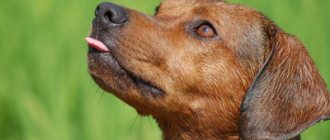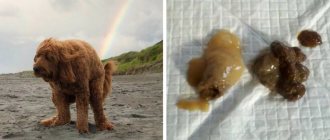Why do you give a dog an enema?
An enema is the introduction of aqueous, medicinal and herbal solutions into the rectum for the purpose of treatment or cleansing. Once inside the body, the liquid lingers for several minutes and then comes out, removing stagnant feces, toxins and waste. A certain amount of liquid, along with medicinal elements, is absorbed into the intestinal walls and enters the blood, which has a good effect on the general condition of the patient. Indications for manipulation include various pathologies:
- stagnation of fecal deposits;
- poisoning;
- elevated temperature;
- diseases of the gastrointestinal tract;
- the presence of worms;
- preparation for analysis.
Only a veterinarian can determine the need and number of enema procedures, but it is forbidden to give a dog an enema more than 2-3 per month. If you do them more often, the organ will stop releasing feces on its own, and lazy bowel syndrome will appear. In addition, the microflora is disrupted: beneficial bacteria die under the influence of solutions, and it takes time to restore them.
When to give a dog an enema?
One of the most common reasons for artificial bowel cleansing is constipation and other disorders of the gastrointestinal tract associated with it. An attentive owner should pay attention to the obvious symptoms of the disease in order to help the pet in time.
Doctors recommend carrying out the necessary manipulation for the dog in the morning. It is best to give a dog an enema for constipation 1-2 hours after waking up, until the stomach is full of food. If you have to do cleansing during the day or evening, then your pet does not need to be fed for several hours before the procedure and for at least 2 hours after it.
When is an enema contraindicated for a dog?
Like any other intervention in the body, forced cleansing can be harmful if you do not follow the recommendations of your veterinarian. There are cases in which enemas are strictly contraindicated. The most serious situation is the bitch’s pregnancy, but there are other pathologies in which the procedure cannot be performed:
- internal bleeding;
- gastrointestinal oncology;
- volvulus and obstruction;
- haemorrhoids;
- ulcers and gastritis;
- fissures in the anus;
- diseases of the cardiovascular system;
- advanced helminthiasis;
- severe dehydration;
- inflammatory processes.
There are warning signs in which the owner should immediately interrupt the process and urgently seek medical advice:
- convulsive manifestations;
- loss of consciousness;
- profuse vomiting;
- acute abdominal pain;
- bleeding from the anus;
- rapid breathing and heart rate;
- a sharp increase or decrease in temperature.
Any of these symptoms or their combination immediately alerts the veterinarian and gives grounds for a more thorough examination of the patient. They should not be allowed to recur, so the doctor most often prescribes other methods of dealing with congestion.
It is not recommended to give an enema to a puppy with constipation on your own, especially if he has not reached two months of age. You may not calculate the dose or choose the wrong composition of the liquid - it is better to leave the treatment to a veterinarian.
Causes and symptoms of constipation in dogs
Constipation is a delay in defecation for 2-3 days; the absence of feces for a week is considered serious. The cause of the pathology can be a variety of factors: diseases of the gastrointestinal tract and other internal organs, incorrectly formulated diet, infection and parasitosis, physical inactivity and old age, hormonal disorders, stress or taking certain medications. It is impossible to find the cause on your own; diagnosis is often required in a veterinary clinic.
But it is not difficult to determine constipation in a pet - its signs include:
- A break in bowel movements for 2-3 days or longer.
- The animal's efforts while going to the toilet do not bring results.
- Scanty excrement, if any, appears very dry and cracked.
- Your pet's stomach is constantly rumbling and bloating.
- Lethargy, low activity, lack of appetite.
- Painful sensations from touching the abdominal cavity.
Treatment for mild fecal stagnation is usually limited to medication and a laxative diet. Forced cleansing is necessary only in severe cases - and only as prescribed by a doctor.
Types of procedure
Based on the depth of administration and temperature, enemas can be warm, cold, contrast, deep or shallow. Deep types are considered to be those that are designed to fill almost the entire intestine (these include rinsing and warming).
Based on the type of action, manipulations are divided into therapeutic, nourishing, rinsing and cleansing. In veterinary medicine, procedures for cleaning or healing the body are common, and nutrient solutions are used only for severely malnourished dogs that cannot absorb food through the stomach.
Medical
Therapeutic enema is intended for the treatment of the lower intestines. Usually it is carried out after cleansing, so that the percentage of absorption of nutrients increases. The treatment procedure is classically carried out in a veterinary clinic; home enema is not common, as it has many nuances.
Cleansing
Designed to remove stagnant feces, it can also be laxative in nature. It is considered the simplest and therefore can be used at home. The most important thing is to get advice on its volume, composition and frequency from a specialist.
Flushing
This is a manipulation that is designed to remove toxins, waste and harmful substances from the body. It should not be confused with a cleansing procedure - rather, it is a variation of the healing procedure, and it requires a smaller volume of liquid.
At high/low temperatures
Prescribed by a veterinarian for hypothermia (hypothermia), hyperthermia (high temperature) or a drop in blood pressure in combination with other therapeutic measures. The temperature of the injected composition must be strictly regulated; for this you will need a thermometer.
Nutritious
This type is rarely used in veterinary medicine - mainly in cases of severe dehydration or exhaustion. Droppers are recognized as a more effective method of treatment.
Treatment of intestinal obstruction
In 9 out of 10 cases, when treating intestinal obstruction in dogs, a surgical (surgical) method is used. The exception is partial obstruction (for example, blockage of the intestines with sand or solid feces), for the elimination of which it is sufficient to use enemas. In other situations, emergency surgery is prescribed.
To facilitate bowel movements, natural oils of plant origin are introduced through the oral cavity. Laxatives should only be prescribed by a veterinarian with caution.
Surgery to treat intestinal obstruction in dogs is performed under general anesthesia (anesthesia). The surgical technique is determined by the factor that provoked the development of the disease in the animal.
If no necrosis is detected on the intestinal walls and blood circulation is maintained, then the veterinarian’s task is to ensure maximum safety of the organ. If the necrotic process has already begun, then the affected area is completely removed.
How to properly give an enema to a dog
The forced process of cleansing the intestines cannot be called pleasant. Even correctly performed manipulation will cause discomfort. Experts advise doing it quickly and confidently.
In order for everything to happen without delays, you should prepare the devices in advance, study the sequence and find an assistant.
What you need to prepare
First you need to find tools and auxiliary materials. You can buy them at a pharmacy or veterinary clinic; some of the devices can easily be found in any home. Everything is prepared taking into account the age and size of the pet. For enema you will need:
- A syringe that is convenient to use for puppies. A needle is not useful in this case, and it is better to put a tube from a dropper on the tip of a plastic device. This measure will help avoid injury to the anus.
- A pear-shaped syringe is used for small and medium-sized breeds. The volume of the rubber product can be from 30 to 700 ml.
- Esmarch mug, suitable for large animals. It is sold as a soft heating pad with a long hose, sometimes with clamps and regulators.
- A solution for administration, which is prepared shortly before the procedure. Volume and proportions are calculated depending on the weight of the four-legged friend. Use only boiled water, cooled to the required temperature.
- Additional materials and equipment: Vaseline or baby cream for lubricating the tip, rubber gloves, diapers, wide basin, muzzle, clamps.
In any case, the dog will resist, try to break free and run away. You need to adequately assess your strengths and seek help. It is impossible for the same person to administer fluids and hold the pet. Only two adults can handle it – even if the dog is a small breed. Toy terriers and Spitz dogs can put up serious resistance that no one expects from them. Large individuals, on the contrary, can please the owner with endurance and patience.
In any situation, the main thing is to remain calm and not raise your voice at a frightened dog. Affectionate and deft handling will help him endure unpleasant treatment with the least amount of stress.
How to determine volume
The volume depends on the indications for the procedure and the size of the dog. Deep enemas are designed to fill the entire intestine - these are cleansing and warming/cooling types. For them, the following calculation is made: 250 ml for every 5 kg of animal weight. For a twenty-kilogram dog you will need one liter of solution, for a baby of 1-2 kilograms - only 50-100 ml.
Nutrient and therapeutic enemas have a smaller volume. Here the calculation is made only by a veterinarian; independent prescription is excluded.
How to perform the procedure
The place where the manipulation will take place should be comfortable and easy to clean. The floor is covered with a waterproof diaper or other non-conductive material. If your four-legged friend feels well, then you can do this in the courtyard of a private house. It is recommended to put a muzzle on him or simply hold him tightly, but you should not cause him additional pain. The algorithm for performing the actions is simple:
- While stroking and soothing, place the patient on his side.
- Wearing disposable gloves, pour the required amount of solution into the syringe or Esmarch mug, lubricate the rubber tip with Vaseline or baby cream. Do the same with the dog's anus.
- Insert the end of the syringe into the anus no deeper than 2-3 cm, parallel to the spine. Force cannot be used: actions must be slow and gentle.
- Slowly, without strong pressure, pour water into the rectum. Liquids should flow freely without encountering obstacles. Otherwise, the procedure stops immediately.
- After introducing all the prepared liquid, the tip is pulled out, and the pet’s tail is pressed to the anus for 10-15 minutes. Keeping the solution inside is necessary to soften the stool.
- After the specified time, move the basin, place the dog’s hind legs in it and wait for the bowels to completely empty.
After an unpleasant process for your pet, do not forget to praise and bathe him. If an obstacle appears when introducing fluid into the organ, the operation must be interrupted immediately. Perhaps there was a foreign body, a lump of worms or a neoplasm in the path of the water. In any case, immediately contact a veterinary clinic.
Solution for administration
The introduction of liquid into the intestine acts in different directions: it softens stool, removes them with parasites and toxic substances, restores water reserves, and starts motor skills. Medicinal compositions, infusions and decoctions of herbs have a beneficial effect on the walls of the organ, providing a calming, antiseptic and restorative effect.
The simplest remedy for enema for a dog with fecal obstruction is considered to be simple boiled water - warm or cooled. It is allowed to add infusions of medicinal herbs (chamomile, oak bark), table salt and soda, potassium permanganate, nutrients (glucose), oil components (vaseline, glycerin, fish oil). But adding alcohol, lemon juice or vinegar can negatively affect beneficial microflora and worsen the patient’s health.
A specialist will help you choose a cleansing composition. Having found out what the problem is with fecal stagnation, he will prescribe the solution that will best affect the dog. For example, herbal decoctions and soda help reduce inflammation, and glycerin, petroleum jelly and soap will quickly soften excrement. The use of potassium permanganate helps fight parasites.
A new solution is prepared for each procedure. It is mixed immediately before the manipulation. The most popular compositions:
- Warm water with added table salt: 20 grams of magnesia and 30 grams of table salt. The mixture is diluted with 100 ml of cold water and then dissolved over low heat. The liquid is introduced slightly warm.
- Saline solution, which is mixed from 30 grams of ordinary salt and 1 liter of water. The composition should be poured in gradually, in portions of no more than 50 ml.
- Chamomile infusion. Chamomile is poured with boiling water and infused for 30 minutes. For 1 liter of water take 1 tablespoon of dry chamomile. If you used not bags, but a scattering of flowers, then before the procedure you need to strain the decoction.
Each cleaning composition has contraindications that affect the health of the four-legged animal. If it is not possible to consult a veterinarian, it is better to use ordinary boiled water.
If you don’t know how to give a dog an enema for the first time, ask your relatives or friends - those who also have a dog at home - to help.
What volume should I choose?
The “pear” is filled with water brought to 37°C, cold water – to 29°C. The amount is determined by the size of the dog and the type of enema used.
| Dog size | Volume, ml |
| Large | 1000 |
| Average | 250 |
| Small | 50 |
Therapeutic microenemas are made for rapid absorption of administered medications; their volume does not exceed 0.05 liters and depends on the breed.
Danger of constipation
Don't think that constipation is harmless. A one-time and mild case may pass without consequences, but a long absence of bowel movements or regular relapses can cause a lot of harm to the animal’s body.
Consequences and complications
Not a single constipation is complete without intoxication - the products of rotting stagnant masses penetrate through the walls of the clogged intestines into the body, having no other exit routes. This affects the general condition of the unfortunate pet: he becomes sad, loses activity and appetite, and his immunity decreases.
The second serious problem is internal damage, such as inflammation, cracks in the intestine and anus, and micro-tears. All this takes a long and unpleasant time to treat, and in advanced cases it can leave an imprint for the rest of the animal’s life.
Pain is not the last thing that worries your pet. He can experience the whole gamut of pain: from a weak aching to an unbearably sharp nature.
Complications can appear even after a single constipation: internal injuries, impaired peristalsis, death of microflora. If the cause of the problem is not found out in time, the disease can become chronic.
When to contact a veterinarian
If you notice your pet has not had a bowel movement for three days, it is worth taking him to the clinic or at least calling the veterinarian. are considered more serious :
- scanty dry stool with foul-smelling mucus or blood;
- severe bloating;
- complete refusal of food and water;
- repeated vomiting;
- severe pain when palpating or defecating.
The owner may not even realize how bad the pet is feeling. Therefore, you should not prescribe treatment procedures on your own or expect that everything will go away on its own - the help of a veterinarian is mandatory in any case.
Folk remedies
Traditional recipes for constipation in dogs do not act as quickly as medications, but cause less harm to the body and cause minimal side effects.
The safest and most effective laxative is Vaseline oil, which does not harm the dog’s body, softens stool and promotes normal bowel movements. The dose is calculated as follows: representatives of small breeds are given half a teaspoon, medium breeds – a teaspoon, large breeds – one and a half teaspoon, dosage frequency – twice a day.
Vaseline oil
In addition, to alleviate the animal’s condition, you can use:
- a weak infusion of buckthorn - steam a teaspoon of the herb with a glass of boiling water, leave for half an hour, give the dog a little water throughout the day;
- infusion of pumpkin seeds - to prepare, pour a teaspoon of raw material with half a glass of boiling water, leave for half an hour;
- Flax oil should be given twice a day, the dose for large individuals is a tablespoon, for small individuals – a teaspoon.
For mild constipation (stool is present, but it is difficult to pass), sometimes it is enough to change the dog’s diet and pay attention to the animal’s activity. Sweet, fatty and smoked foods, dough products, eggs, hard cheese and bones should be excluded from the menu. For defecation disorders, liquid porridges, stewed vegetables, low-fat kefir and yoghurt are useful. Food should be given to the animal in a warm, ground form in small portions at least three to four times a day. If your dog eats dry food, you need to review its composition and switch to dietary varieties.
Defecation disorders in dogs can be treated with folk remedies
Attention! Constipation is not an independent disease, but a symptom of various pathologies, therefore, to completely eliminate problems with bowel movements, you need to identify their cause and get rid of it.
Video - Constipation in a dog
Preventing constipation
Simple measures will help you avoid digestive problems. For example, a dog’s fairly active motor activity has a good effect on the functioning of the gastrointestinal tract and prevents constipation and other troubles. You should spend time with your pet, take long walks, jogs with him, and play active games in the fresh air. Physical activity must correspond to the breed, age and character of the four-legged pet.
The diet should contain enough fiber necessary for good digestion. Individuals predisposed to lazy intestines should include vegetable dishes and bran in their menu. Industrial feeds already contain components that are beneficial for the intestines. Maintaining the correct drinking regime, enriching food with vitamin and mineral complexes, love and affection from humans will help maintain good health for your pet for many years.
Only a veterinarian can prescribe forced colon cleansing. The owner’s task is to correctly follow his recommendations, understand how to give a dog an enema at home, and help the pet in a timely manner. It is possible to determine the cause of constipation and prescribe the administered composition only after examining the patient, since there are a number of contraindications. Prevention includes physical activity and a balanced diet.
The article is for informational purposes only. Contact your veterinarian!
Do you like the article? 129










